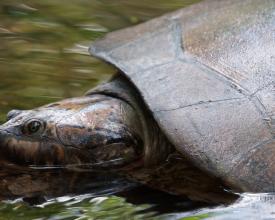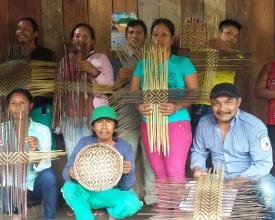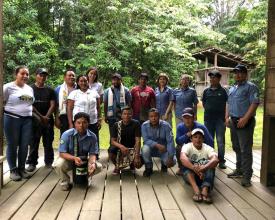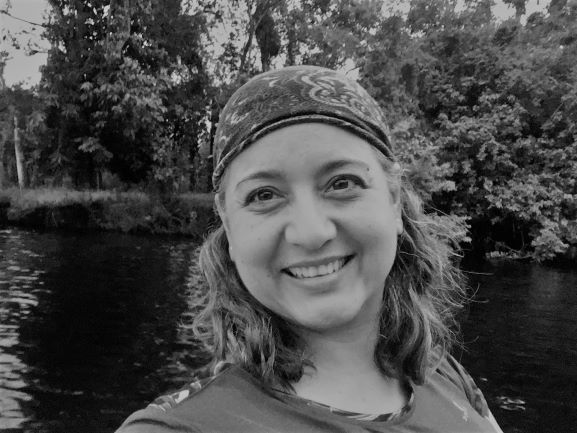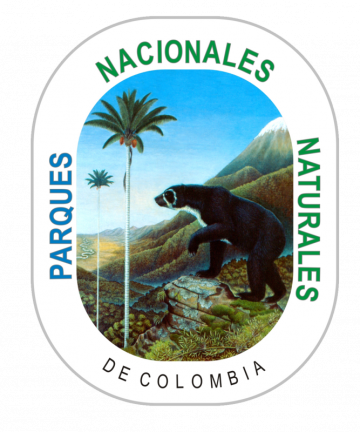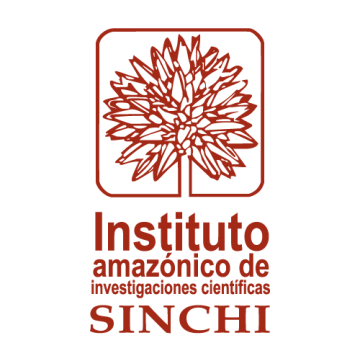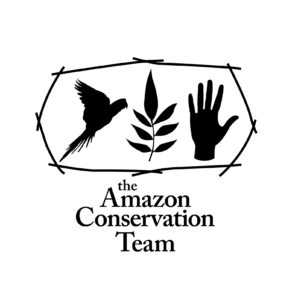
PNN CAHUINARÍ: A STORY OF SHARED GOVERNANCE IN THE COLOMBIAN AMAZON
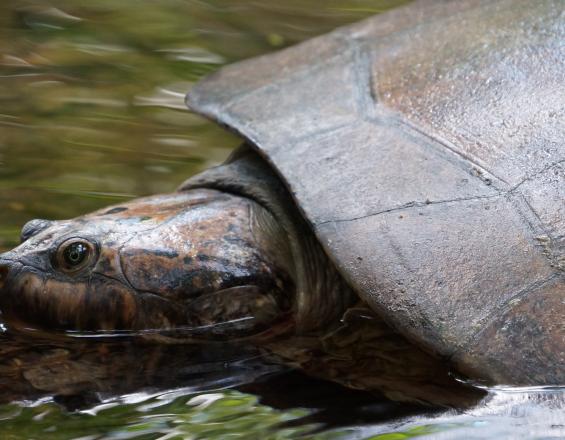
It took 9 years to formalize the Special Management Regime for the Cahuinarí National Natural Park, time that passed between a large number of meetings, talks, mambeo (indigenous ritual) days, late nights and many discussions. The dialogue of knowledge, the wait and the hard work were worth it, today this REM is the planning instrument that contemplates the governance model for Cahuinarí, it is coordinated by 3 instances that include the indigenous communities and the traditional authority of the territory. In its implementation, agreements have been established that regulate the use of natural resources within the communities, in different areas of the territory and in the border areas between the PANI territory and neighboring areas, and eight Integral Conservation Priorities have been identified, one of them, the chagra, where women play a leading role, and another, the charapa turtle, which integrates entire families in the work for its conservation.
Context
Challenges addressed
- The REM recognizes the PANI association (Piine Ayveju Niimu'e Iaachimu'a) as the Special Authority and as an entity with the capacity to sign agreements. It is the first REM in the Colombian National Natural Park System (SPNNC) that unifies the planning and management of the PA, and therefore does not require an additional planning instrument, which is an achievement for National Parks and control entities.
- The REM develops the cultural zoning exercise that supports the need to make the construction of the management component flexible and inclusive.
- The exercise was based on the conceptualization of the public function of conservation, the principle of co-responsibility and the constitutional principle of coordination, which had to be developed from the legal, political and technical spheres. As a result, these principles are accepted as the basis for the relationship throughout the SPNN.
Location
Process
Summary of the process
All the processes that take place in Cahuinarí NP function in harmony thanks to the REM. For this reason, the relationship with the indigenous people is an achievement that has allowed the articulation between all the processes that are carried out for the implementation of the PA's management regime.
Gaining trust between the parties as well as understanding the two visions and their complementarity were the starting point, from then on, collective construction, dialogues, among other important processes, have led to synergy in the work of the territory and to the success of this governance model.
In addition, the information gathered through the control and surveillance tours and turtle monitoring, which are exercises implemented through the REM, have functioned as participatory processes and the construction of joint learning, which has included intergenerational elements and gender roles, giving added value to the activities that are developed there.
Building Blocks
Rituals that contributed to good relations between indigenous people and PNN personnel during the construction of the REM
Building trust and generating good relations with the indigenous communities during the construction of the REM was possible thanks to the interaction that was maintained with them through meetings, events generally held in a maloca where the mambe and the ambil were the catalysts for a harmonious exchange of knowledge.
Enabling factors
Once a good relationship between the parties was achieved and it was understood that their common denominator was the conservation of fauna and flora species, the contributions of nature and the traditional culture of their territory, framed in respect for the different visions, the work of collectively building the Special Management Regime became easier.
Lesson learned
The PNN chief and his work team had to adapt to rites, visions and practices that were unusual in their western culture, but when they understood them and were then invited to participate in them, it meant acceptance.
The exercise of the Environmental Authority in the framework of the implementation of the REM
There are several exercises that take place within the framework of the implementation of the REM, for example, the Prevention, Control and Surveillance tours that are carried out inside and in the area of influence of Cahuinarí NP and that are part of the institutional mission of PNN.
It is the traditional person who decides whether or not the tour can be done and under what regulations. The interesting thing about this exercise in the PA is that the traditional and cultural component has been included in the tours, which is why, prior to each outing, a night meeting is held so that in the midst of the wisdom of the mambe, the ambil and coca, the tour that is going to be done is conjured.
At the end of each Control and Surveillance tour, the results of the exercise must be socialized and discussed in a meeting under the same conditions as the initial one, and it is also used to try to find out if anyone in the team has contracted any disease before returning home. This is due to the fact that many places in the territory where the tours are conducted are sacred sites and if there is not a good preparation or disposition it is very likely that some type of disease is acquired, therefore the traditional one must conduct a night session of mambeo after these tours to "get the possible disease out of the body".
Enabling factors
- Inclusion of the traditional authority
- Permanent communication between the park team and the indigenous community.
- Generation of trusting relationships
Lesson learned
- It is possible to combine the traditional and cultural in the moonitoreo and research exercises.
- In case there are women in the PA team, they should follow the instructions given by the Traditional, even if they indicate their non-participation.
Traditional ancestral wisdom and its importance for decision-making in PA management processes.
During these days, the wise men, from their broad knowledge of seeing things that are difficult to identify to the eye of a common man, dialogue with the one who is culturally known as the creator of all things, who gave to men the management of all his creation, to serve them during their lives as tools with which they could develop the work with their families, community or as now, in an organized way in the association.
During the time of concentration in dialogue with the creator, the traditional knowledgeable ones, transmit the message of the works to be carried out internally that as an association can be advanced without problems, in addition the possibility is reviewed that in the exchange of thoughts with "the target" there are no inconveniences, as long as, this is done in a coordinated way, allowing the activities to be developed to obtain the best results.
Enabling factors
The orientation is based on respect for others in every sense, responsibility and an appropriate behavior with nature; therefore, the management standards for the work between PANI, government institutions and NGOs are emphasized.
Lesson learned
Conflicts or doubts that may arise with respect to cultural management will be resolved by approaching the major council.
The role of indigenous women in EMN
Women are part of the governance of Cahuinarí NP, under the regulations that govern the community. They play an important role in the economic, educational and productive fields, and are relevant in the economic support of the family. They are in charge of managing the chagra (Chagra = Food = Life) where knowledge is transmitted to the younger generations. Children are taken to the chagra from a very early age and at around 5 or 6 years old they begin to participate in the cleaning and harvesting of the chagra.
Environmental education is also carried out by the women; it is a very interesting exercise in which they are the teachers and in order for their work to be successful, they receive help in the construction of training plans and the use of technological tools from the PNN team, which is in charge of providing training to improve their skills.
Enabling factors
Currently, councils are beginning to be formed in which they have a very important role because they participate and have a say in the decisions that are being made with respect to territorial management and relationships.
Lesson learned
However, although the "white woman" is perceived as a normal person who is allowed to break some rules such as mambear or place herself anywhere in the maloca (things that native women cannot do), when decisions must be made, she is considered one more woman who must comply with the rules of the women of the territory."My appreciation is that the indigenous people see or position the white woman in an intermediate point of the relationship and that the balance tips to one of the two sides if this woman assimilates her role and integrates herself to the processes of her gender".
The conservation of the charapa turtle and its importance for the indigenous peoples of PANI
The charapa (Podocnemis expansa) in the indigenous cosmovision is related to the origin of the people, especially the Miraña, they say that an ancestral god gave them to the grandchildren to feed them. In addition, it has healing powers that are associated with the ecosystems that the species uses to carry out its reproduction, that is why the charapa is present in their dances and rites. Its consumption is allowed under regulations contemplated in a cyclical calendar that mixes ecology and conservation with the indigenous cosmovision and that establishes management, because if they abuse its consumption, diseases are attracted to the territory. The conservation of the charapa is a successful result and has been achieved thanks to community monitoring coordinated by PNN and PANI. The community has been sensitized and use agreements have been made to ensure that the turtle population is maintained or increased. This work has allowed the participation of one of its indigenous people in an exchange of experiences with ongoing projects in Colombia and other countries, as well as their participation in a scientific article published by several South American authors.
Enabling factors
The turtle monitoring is implemented by the indigenous community, where entire families work in these special protection zones, doing citizen science exercises and helping in the research of the species. The results of these 5 years of monitoring are obvious, there is a very important scientific-environmental and cultural component, the postures are monitored, the adults and in times of high water, the sites where the turtles perform other activities related to feeding are monitored.
Lesson learned
Being a community work, charapa monitoring has helped to structure PANI's governance system, since it has allowed them to strengthen themselves, has generated a very important reference that has led to neighboring indigenous communities requesting to be linked to the exercise, to be socialized and taught about the subject and to be included so that they can carry out similar exercises. Therefore, the exercise has grown and expanded, creating a biological corridor for the conservation of the species.
Resources
Community-based tourism, a production alternative
In the framework of the implementation of the REM, in 2016, productive alternatives were included as part of the management strategies, a real challenge where the distance and lack of communication makes everything difficult, an alternative was sought that could be taken there under these conditions, taking into account that there were already projects such as handicrafts, resins and other typical products such as chili bell pepper with which there were no successful results because they had an extractive vision, in addition they faced the complex mobility of the region.This is an exercise that is still in the process of construction and strengthening for the area of influence. Remote work has been done in this situation of pandemic and public order problems, but progress continues to be made. There have been good professionals working on the issue and successful results have been obtained, being one of the parks that has made the most progress in the tourism proposal thanks to the degree of maturity of the work team.
Enabling factors
Tourism is proposed as a conservation strategy, with a maximum of 12 people and 3 or 4 entries per year with restricted sites and activities, for which training exercises have been carried out in the territory. The issue of maintaining indigenous knowledge is of course a principle, offering tourists, for example, handicrafts in the same territory, is a different strategy in which the products are produced there and the tourist is the one who takes them out, thus reducing the challenges of transportation.
Lesson learned
Taking into account the above and after conducting a diagnosis it was concluded that community tourism would be the best option, taking advantage of the fact that since 2016 we have been working on financial management, provision of the malocas, construction of basic sanitary services, kitchen, training of the communities and have made a couple of entries of tourists to see how they respond to the strategy, obtaining good results.
Impacts
- The community monitoring program for charapa and terecay turtles, supported by the Frankfurt Zoological Society, has a protocol agreed upon by communities and traditional knowledgeable people of the PANI territory. The results have been of great importance for the protection of the charapa species mainly, and have laid the groundwork for the expansion of the monitoring proposal to other areas outside the PANI territory and the PA. The monitoring strategy began in 2014 in two areas, during which time about 2000 turtles were recorded nesting, today we are working in five areas that are approximately 16 nesting beaches and the record amounts to an average of 6000 breeding females.
- Recognition of the culture, principles and norms of coexistence, as well as the traditional indigenous cosmovision.
- The REM is articulated with PANI's Life Plan and with Cahuinarí's mission objectives, demonstrating that it is possible to conserve biodiversity and the culture of its ethnic groups, in a space where both complement each other in order to effectively manage the PA.
- The shared governance between the National Natural Parks and the indigenous authorities has allowed them to join the Cahuinarí National Park team as officials, contributing to the strengthening of governance and a better understanding of the traditional management of the territory.
Beneficiaries
- 447 people belonging to 97 families of the Bora Miraña peoples
- Biodiversity that integrates the Cahuinarí National Park and its zone of influence.
-
Associations of Indigenous Authorities - AATI present in the lower Caquetá river basin in Colombia.
Sustainable Development Goals
Story
Cahuinarí was declared a National Natural Park in 1987, its creation and application of the regulations in this context of the Amazon generated conflicts with the indigenous communities of the territory, however, as they were linked to the work team, relations improved and thus began the process of construction of the Special Management Regime.
Why do we talk about a REM? Because the Protected Area is also an indigenous reservation, this condition makes it "special" and implies political, legal and cultural aspects within a space where two different visions converge, with the common interest of conserving the nature and culture of their territory.
The signing of the PA coordination agreement between the Ministry of Environment and the Bora Miraña people took place in 2001, and then, countless talks, mambeo days, late nights, and discussions led to the formalization of the REM in 2010.
The Cahuinarí REM, signed with PANI, the indigenous association of the Bora Miraña people, is a governance instrument that connects cultural and traditional elements. It was built in an environment of different visions and complexity in the relationship with the community and is recognized as a process of collective participation and inclusion among stakeholders. This has become the premise for all processes that are now managed in the territory, research, monitoring, productive development, etc; and is coordinated by PANI communities, PA work team, local committees and the traditional authority.
Although the time it took to build and formalize the REM is transcendental for the PA's history, its implementation process is even more so. In the course of its implementation, progress has been made in other significant processes: the monitoring of the charapa turtle, the chagra, and productive alternatives, which are part of the park's eight Integrated Conservation Priorities.
Cahuinarí's REM is successful and important because it is the first in the country and is the result of a profound intercultural dialogue in which a protected area is the axis. In addition, there is currently a close relationship of cooperation and local coordination, based on respect for the indigenous cosmovision.

